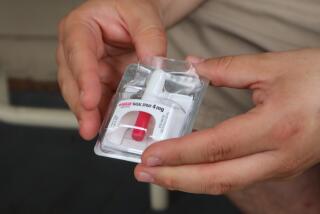Narcan could be required at California schools after youth fentanyl overdoses

- Share via
SACRAMENTO — Following spates of fentanyl overdoses among students, California public schools could be required to provide Narcan on campuses — a nasal spray that can reverse deadly effects of opioids.
The proposal is part of legislation introduced by both Democratic and Republican state lawmakers this week that aims to increase information about the presence of fentanyl on K-12 campuses, which can be fatal and consumed unknowingly when it’s hidden in other drugs such as oxycodone and Adderall.
The Los Angeles Police Department reported that at least seven teenagers overdosed from pills possibly containing fentanyl this year, including a 15-year-old girl who died in September.
In the opening week of the new legislative session, Assemblymember Joe Patterson (R-Rocklin) introduced Assembly Bill 19, which would require schools in California to have at least two doses of emergency naloxone such as Narcan on campus in case of an overdose.
Patterson, a father of four who was sworn into the state Legislature on Monday, said the issue is bipartisan and he’s faced no opposition to the legislation.
But the details of the proposal — including the undetermined cost — could be tricky. The legislation comes as California is facing an estimated $25-billion budget deficit, and state programs that offer Narcan are already in high demand.
“I do think the state will have an obligation to pay for this in our schools if they’re mandating schools do it,” Patterson said. “It’s not going to be the smallest of costs, but it’s definitely a lot cheaper than the health effects associated with being on this drug and saving a life.”
Patterson said he would like Narcan to be on all of the more than 10,000 K-12 campuses in California but is open to starting with just middle and high schools if needed because of cost and supply constraints. While big districts in Los Angeles, Sacramento and Fresno already stock the medication, not every district has the funds or motivation to do so on their own, Patterson said, and comprehensive, statewide public education is needed.
The legislation was inspired by the death of his Rocklin neighbor, Zachary Didier, who died at 17 in 2020 after ingesting what he believed to be a Percocet pill he bought through Snapchat.
“I had no idea how kids were getting their hands on fentanyl — that they were being poisoned — until there was a tragedy,” Patterson said.
State Sen. Dave Cortese (D-San Jose) also introduced Senate Bill 10 this week, which would require schools to include “opioid overdose prevention and treatment” as part of their annual safety plan, in addition to supplying Narcan and training.
The bill is modeled on a program run by the Santa Clara County Office of Education, where schools can partner with public health officials to inform students about the signs of opioid overdose — like abnormal breathing — and to beware of unknown substances.
Narcan was used at least twice this school year to “revive an unresponsive student,” according to a spokesperson for the Office of Education.
In Santa Clara County, fentanyl-related overdose deaths rose from 29 in 2019 to 135 in 2021, according to the Office of Education. Statewide, fentanyl deaths accounted for more than 80% of all drug-related deaths among young people in 2021, according to the California Department of Education.
Santa Clara County and school districts already supplying Narcan do so with the help of state or local public health departments at no cost, and school nurses and volunteers received training to administer it.
Cortese said he is working on ideas to fund a statewide program that would not exclusively depend on general fund money from the state budget amid concerns of a looming recession. He pointed to Proposition 63, a tax on millionaires that voters approved in 2004 to fund a variety of mental health services, as one possibility.
Cortese’s bill also includes a “restorative justice” component that would discourage schools and local law enforcement from punishing students who may need Narcan, especially since accidental consumption is common.
“I don’t think that dealers and cartels should go unpunished. It’s appropriate when people are poisoning and killing people. But what about the kid who was trying to score cocaine and ends up with fentanyl?” he said. “I think we make a big mistake if we say anybody, anywhere that is in possession of fentanyl gets a felony hung on them or thrown out of school. I don’t think that’s going to get us where we want to go.”
Some schools launched education campaigns about fentanyl this year. In an email to parents in October, Sacramento City Unified announced that its schools would now have Narcan on campuses, supplied by the state. The district warned of “rainbow fentanyl,” which can come in a variety of bright colors and resemble “sidewalk chalk or candy.”
“Stress not to take any pills that were not prescribed to you from a doctor,” the email advised parents.
Naloxone is a life-saving medication that reverses the impacts of an opioid overdose and can come in a small nasal spray that is promoted as easy to use. Projects across the country seek volunteers willing to learn how to administer it and carry it on their person.
In the first half of 2021, fentanyls were identified in more than 77% of adolescent overdose deaths in the U.S., according to a study published by the Journal of the American Medical Assn.
Supt. of Public Instruction Tony Thurmond has urged school officials to “take immediate steps” to address the fentanyl crisis.
“While we have dealt with painful epidemics and spikes in illicit drug use before, there are elements of this crisis that are different. Often, teens think they are purchasing Adderall, OxyContin, Percocet, or Xanax pills, but drug dealers are making these fake pills with the cheaper, stronger, and deadlier synthetic drug fentanyl,” Thurmond said in a letter to principals and superintendents.
More to Read
Sign up for Essential California
The most important California stories and recommendations in your inbox every morning.
You may occasionally receive promotional content from the Los Angeles Times.











